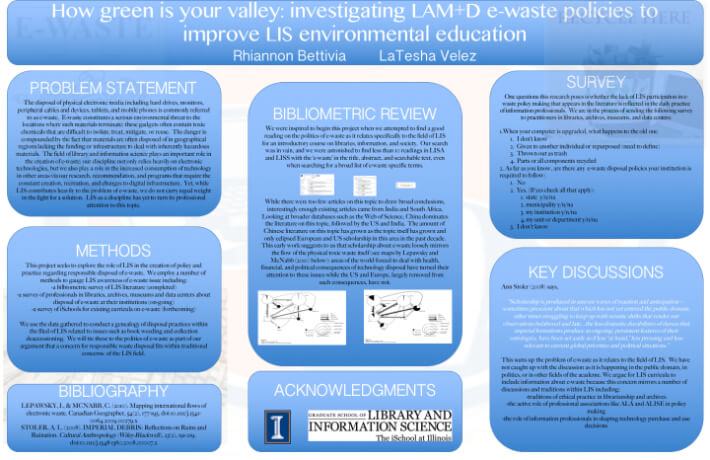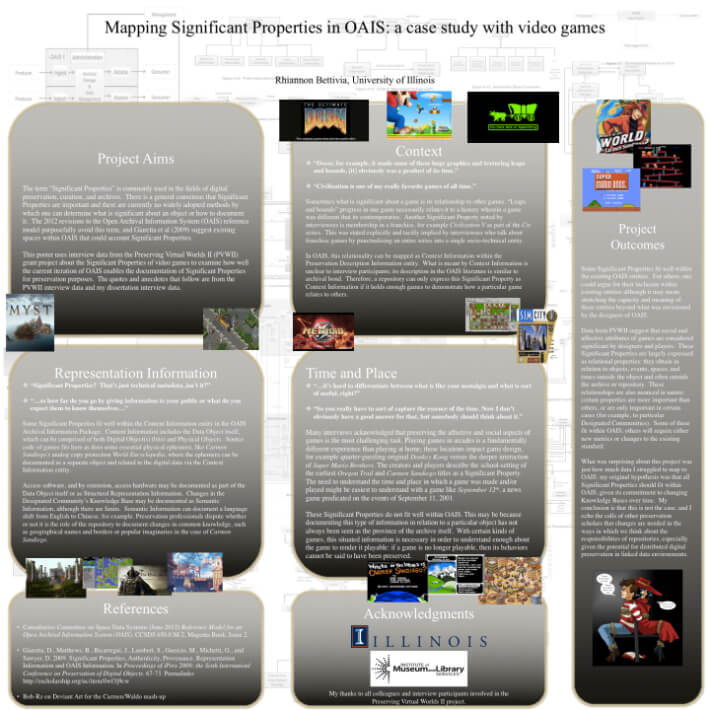Archived Posts
-
iConference 2018
I will be presenting at iConference 2018 in Sheffield, UK with my co-author and frequent collaborator, Elizabeth Stainforth (University of Leeds). Our paper, Performative Metadata: Reliability Frameworks and Accounting Frameworks in Content Aggregation Data Models, explores the potential motivations for practitioners to engage with RDF-based argumentation schemas. See the full abstract below:
Metadata is not a new concept: it has existed for hundreds of years, with different forms and functions. In contemporary settings, we think about metadata serving administrative, descriptive, and technical functions. These roles are often in the service of common goals to identify information so that it can be found and used according to the discipline or industry from which it comes. But as modes of accessing and using information change, so too does the role of the data about that data, the metadata. Even if the metadata itself does not change, it comes to serve new functions, and these functions merit additional study. In this paper, we argue that in the contemporary political landscape of information, metadata schemas stemming from distinct ontological approaches take on fundamentally performa-tive roles, and different underlying approaches mean that the performativity of the metada-ta is also enacted differently.
-
ASIS&T 2016
In October 2016, I presented at ASIST’s annual meeting. My paper The Power of Imaginary Users: Designated Communities in the OAIS Reference Model was drawn from dissertation and other grant research. See an abstract of the paper below.
This paper explores the Designated Community term within the Open Archival Information System (OAIS) Reference Model. Information practitioners, particularly those who work with varied populations and popular materials such as public- or state-sponsored libraries and museums, complain that this term is counter to their professional, ethical, and legal mandates to serve many types of user. Using interview data from digital preservation practitioners and scholars as well as interview data from OAIS authors, the author examines the meaning and history behind this term and what it prescribes for professional digital preservation practice. This work juxtaposes contentions of digital preservation practitioners with explanations provided by the authors of OAIS about the Designated Community term. The findings in this paper support the author’s contention that alternative digital preservation models and metrics are necessary within cultural heritage institutions, like libraries and museums, to meet the professional standards of practice in those areas and to ensure the inclusion of broad populations within the user bases of digital repositories.
-
iPres 2016
In October 2016, I presented Mapping Significance of Video Games in OAIS, examining the controversial term ‘significant properties’ in relationship to the OAIS 2012 revisions using video games as a case study. See the abstract below.
In this paper, I explore the concept of significant properties and how such properties do and do not fit within the Open Archival Information System (OAIS) Reference Model. Combining interview data from research about the deployment of OAIS in cultural heritage institutions with data about video game production and preservation from the Preserving Virtual Worlds II (PVWII) grant project, this paper maps stakeholder-identified significant properties onto the 2012 version of OAIS. Significant properties have many definitions and even many names. Operationalizing this term broadly, many such properties do fit within existing OAIS entities. However, significant properties that are relational and external to digital objects’ code and environments do not. This paper concludes that additional metrics are needed to begin shaping the process of documenting significant properties at scale.
-
ACHS 2016
In June, colleague Elizabeth Stainforth (University of Leeds, UK) and I presented our paper All and Each: The Dynamics of Scale in Digital Heritage Cultures at the Association for Critical Heritage Studies Third Biannual Conference in lovely Montreal, Canada. I would like to thank all the presenters from our 2-day panel, especially Dr. Yujie Zhu (Australian National University) for convening the panel and David C. Harvey (University of Exeter, UK) for acting as respondent to our paper. See the extended abstract here and a short blurb below.
This paper investigates Foucault’s theory of all and each in governmentality as it relates to the digital cultural heritage project, “Europeana.” Europeana is one of the more recent attempts by the European Union (EU) to confirm Europe as a unified entity through the notion of a shared cultural heritage. Funded by the European Commission (EC), the EU’s executive body, Europeana demonstrates this move very clearly; it is precisely the involvement of individual users and organizations that furthers its aim to promote a distinctly European space online for heterogeneous cultural objects and experiences. A similar political imperative is implicit in its technical functionality and examination of these elements reveals the myriad scales at which Europeana operates: from a single node of the data model to the larger, supranational scope of the web portal. This case study will provide a way into thinking about the mediation and structuring of relationships between individuals and organizations, and about techniques of government as exercised through large-scale web aggregations. Such techniques operate at the level of the continual reconstruction of user identities within the wider frame of digital heritage cultures.
-
Dissertation Defense
In May, I successfully defended my dissertation entitled “”Encoding Power: The Scripting of Archival Structures in Digital Spaces using the Open Archival Information System (OAIS) Reference Model,” at the Graduate School of Library and Information Science at the University of Illinois, Urbana-Champaign. My most sincere thanks to those who kindly consented to participate in interviews about their experiences with the OAIS reference model; the thesis was grounded in the findings from these interviews. I also offer my most sincere appreciation to my committee: Jerome McDonough, chair (University of Illinois); Kari Kraus (University of Maryland); Anita Chan (University of Illinois); and Kevin Hamilton (University of Illinois). See the abstract below, and find a full copy here.
The Open Archival Information System (OAIS) Reference Model is a corner stone of the evolving discipline of digital preservation. It undergirds many of the systems that are used in daily practice in organizations engaging in digital preservation, and directly or indirectly influences commercial and open source tools, as well as administrative and personnel functions. Yet it also undergirds the field of digital preservation more generally as its design and revisions have taken place concurrent and in partnership with the growth of the profession into one that has boundaries, curricula, and standards of practice. There is closure around OAIS: it is ever assumed as background or foundational knowledge in new endeavors. It is a black box. Given the pervasiveness of OAIS, this research examines the values scripted into the sociotechnical object it represents. Using discourse analysis, this research traces the power relationships that arise as a result of the discourses that OAIS produces. I also explore the effects on professional practice that occur because of the discourses OAIS brings with it from its scientific origins and archive-informed terminology. The dissertation investigates terms like Designated Community and significant properties in order to lay bare the imperial tendencies scripted within OAIS as well as to expose the resistive and recuperative potential of this technology.
-
ALISE 2016
Check out my work with colleague LaTesha Velez (University of Illinois, Urbana-Champaign), “How Green is Your Valley: A Survey of E-Waste Policies in LAM+D Institutions” from ALISE 2016.
If you work in an LAM+D institution and are interested in taking this survey, please email me and put “E-Waste Survey” in the subject line.
-
ASIS&T 2015
Mapping Significant Properties in OAIS: a case study with video games” from ASIS&T 2015.

